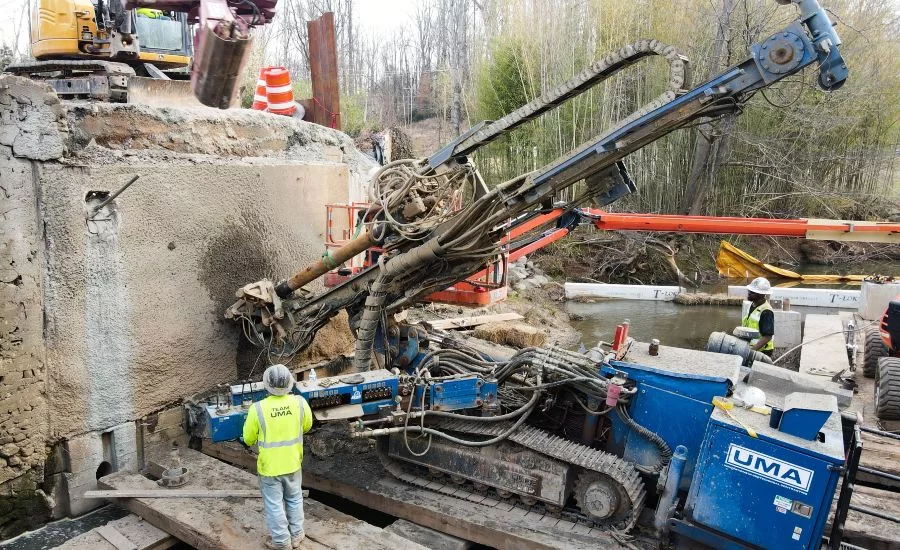UMA Preserves Retaining Wall Structures for N.C. Bridge Demo
Project Involved 14 Ground Anchors, some through Bridge Deck

North Carolina-based UMA Geotechnical Construction this spring helped a customer avoid failure of retaining wall structures during the demolition of a bridge spanning Blanket Creek in the Winston-Salem area.
UMA, under subcontract to Kernersville, North Carolina-based National Bridge Builders, installed 14 ground anchors on two retaining walls held in place by the span targeted for demolition. These walls could have collapsed if not properly secured independently prior to demolition. Traffic had already been rerouted to the new replacement bridge.
“Throughout the duration of this project,” says UMA President Brian DeSpain, “UMA was faced with two main challenges in order to properly and safely install the anchors.”
First, the UMA crew had to attach the top of the anchors through the existing bridge deck in order to achieve the proper installation angle. The bridge itself obstructed access for the work from below.
UMA used duplex drilling to advance both casing and drill steel into each hole simultaneously to keep them from collapsing. After reaching the required 30- to 50-foot hole depth, UMA installed 30- to 54-foot anchors inside the steel casing, with lengths varied based upon location and bar sizes of either #6 or #11.
The bar system that UMA used also incorporated double corrosion protection, specifically Multiple Corrosion Protection (MCP) bars. This type of Class 1 corrosion protection consisted of a bare bar surrounded by a corrugated plastic sheath, which was large enough to allow it to be filled with grout and provided a three-inch solid casting of grout around all sides of the bar. After the hole was drilled to the proper depth, the bar and a tremie tube were placed into the hole, and the hole was completely grouted to the face of the wall.
After the proper grout curing time, the anchors were cyclically load-tested to the specified loads. At the end of the load tests, the anchors were locked off at 50 percent of the designed load in order to engage the anchor.
The second challenge was that the two retaining walls are positioned on either side of an active creek, fed by the nearby Lasater Mill Pond. To achieve the correct anchor installation position, UMA opted to use a semi-elevated platform constructed using crane mats. This allowed field technicians to use the appropriate drill angle while water flowed freely in the creek.
“The successful completion of any project relies on the management and technical skills of the construction team, both in the office and on site,” DeSpain says. “It’s because of the expertise and teamwork of the employees at UMA that the retaining walls were able to be properly secured, a critical step to a safe bridge demolition.”
UMA Geotechnical Construction Inc., a leading developer of polymer grouting techniques, works to save clients money with specialized ground engineering solutions. The UMA team, which includes experts in structural support, earth retention and soil stabilization, was among the first to use lightweight structural polymers to improve subsurface soils at depths greater than 40 feet. For more information, visit www.team-uma.com.
Looking for a reprint of this article?
From high-res PDFs to custom plaques, order your copy today!





